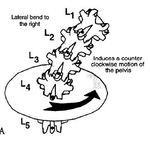razaar
Well-known member
How can the spine be an engine? When it moves like a reptile. Look at a high jumper as they arch their back to get the top of their spine over the bar then use their spine and pelvic muscles to flip their lower body/legs over the bar.
Musical chairs is another where the pelvis and spine does the work to move the body across in the spirit of the game. Marching is another - try marching without using the pelvic spine myofascia. Hulla-hoop is another. Shot putt, hammer throw, javilin.
The real issue here is that most people have little body awareness and have no conception of what goes on during movement. When faced with a discipline such as golf they really struggle to understand the concept of body parts bracing against each other and pulling away from each other, contorting the spine so that it rotates by itself while using the ground as resistance.
I give thanks to Kelvin Miyahira's articles for helping me understand the spine engine concept. Abe Mitchell made an attempt to articulate his golf swing movements in the 1930's which was a pretty fair effort.
In the end we either get it or we don't.
Musical chairs is another where the pelvis and spine does the work to move the body across in the spirit of the game. Marching is another - try marching without using the pelvic spine myofascia. Hulla-hoop is another. Shot putt, hammer throw, javilin.
The real issue here is that most people have little body awareness and have no conception of what goes on during movement. When faced with a discipline such as golf they really struggle to understand the concept of body parts bracing against each other and pulling away from each other, contorting the spine so that it rotates by itself while using the ground as resistance.
I give thanks to Kelvin Miyahira's articles for helping me understand the spine engine concept. Abe Mitchell made an attempt to articulate his golf swing movements in the 1930's which was a pretty fair effort.
In the end we either get it or we don't.








